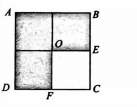Q.
A square of side $4\, cm$ and of uniform thickness is divided into four equal squares. If one of them is cut off $(OECF)$, then the position of the centre of mass of the remaining portion from $O$ is

System of Particles and Rotational Motion
Solution:
